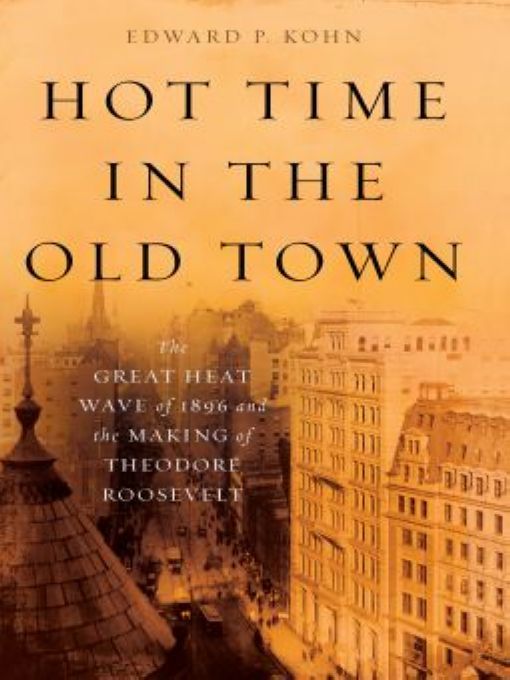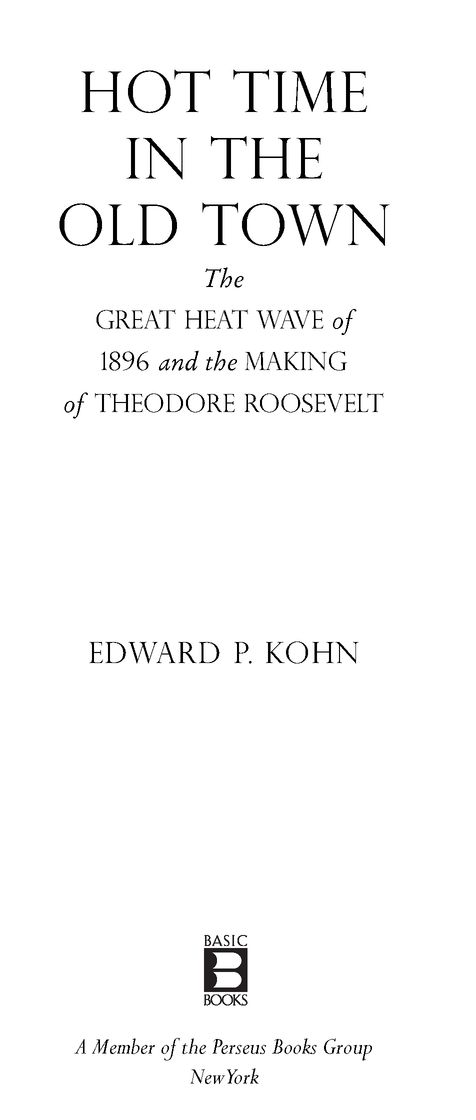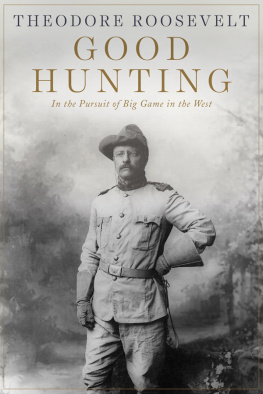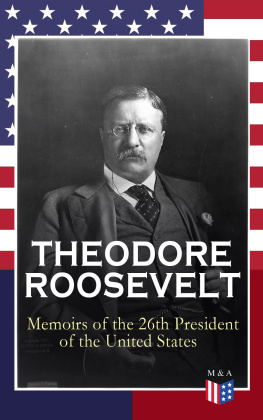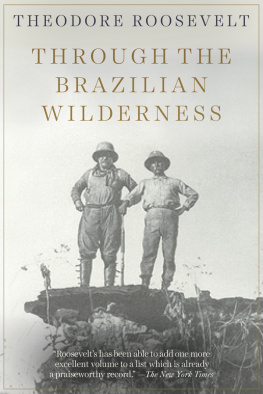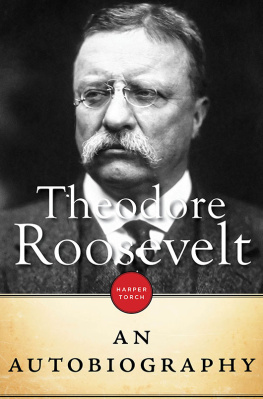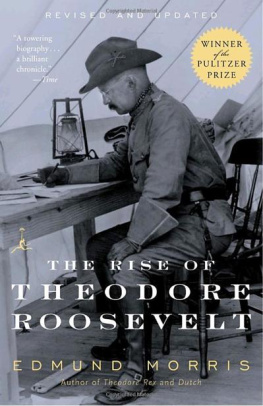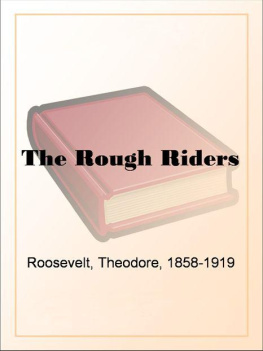Table of Contents
For
my family
PROLOGUE:
THE HEATED TERM
ON AUGUST 15, 1896, while preparing to depart for a three-week vacation out West, Theodore Roosevelt wrote to his sister Anna: Weve had two excitements in New York the past week; the heated term, and Bryans big meeting. The heated term was the worst and most fatal we have ever known. The death-rate trebled until it approached the ratio of a cholera epidemic; the horses died by the hundreds, so that it was impossible to remove their carcasses, and they added a genuine flavor of pestilence, and we had to distribute hundred of tons of ice from the station-houses to the people of the poorer precincts. Roosevelt, then thirty-seven and president of New Yorks Board of Police Commissioners, was describing one of the most extraordinary weeks in the citys history.
The heated term was an unprecedented heat wave that hit New York over ten days in August 1896. Temperatures in the 90s were accompanied by high humidity. For the duration, thermometers never dropped below 70 degrees, even at night, and over the course of a week and a half the heat wave wore New Yorkers down. The eventual death toll numbered nearly 1,300.
Yet the 1896 New York heat wave remains one of the forgotten natural disasters in American history. It is in the nature of heat waves to kill slowly, with no physical manifestation, no property damage, and no single catastrophic event that marks them as a disaster. For that reason the heat wave is only infrequently remembered, even though it claimed more victims than the 1863 New York City draft riots or the 1871 Great Chicago Fire.
Our collective failure to remember this disaster may also have something to do with the identities of the victims. While the very young and very old were the most vulnerable, the heat wave took a terrible toll on the working poor, the death lists containing the names of hundreds of surprisingly young men who were literally worked to death.
The living conditions of New Yorks poor were dire. By August 1896 the entire country had been suffering through a severe economic depression for three years. Millions were out of work. New York, experiencing a wave of massive immigration, seemed particularly hard hit. The tenements of the Lower East Side teemed with recent arrivals who could scarcely afford food or medical care. The combination of poor living conditions, poor working conditions, poor diet, and poor medical care, with temperatures inside the brick tenements easily reaching 120 degrees, killed hundreds of New Yorkers.
Roosevelt compared the heat wave to a cholera epidemic for good reason. Although the heat wave was not an epidemic by any medical definition, the slow unfolding of the tragedy resembled the periodic outbreaks of cholera that had plagued New York throughout the century, more than it did such spectacular disasters as the Great Fire of 1835 or the Blizzard of 1888. Like cholera, the heat in August 1896 struck quietly and undramatically.
New Yorkers remembered 1832s cholera epidemic as the worst they had ever experienced. That summer the disease had swept through the city. Those who had the means to leave town did so as quickly as possible, leaving New York almost half-empty. For the poor souls that remainedquite literally, the poorest of the inhabitantssome neighborhoods took on the cast of Bruegels Triumph of Death. Pedestrians risked being trampled by the hearses that plied the streets day and night. The air was hazy from the burning of the sicks bedding and clothing. Dead bodies lay in the street untouched by the living, who were scared to approach them, while rats feasted on those buried in shallow graves. Turned away from private hospitals, over 2,000 sick New Yorkers swarmed into Bellevue. Attendants stacked bodies in the morgue, while patients lay dying in hallways. In the end over 3,500 died.
It would take concerted preparations to defeat cholera. Epidemics recurred in the 1840s, 50s, and 60s. Finally in 1892, with a new epidemic sweeping across Europe, New York officials prepared to combat the epidemic on the basis of the latest advances in microbiology. Indeed, the city prepared as if for war, readying a special corps of doctors, hospital ships in the rivers for quarantine patients, and an army of workers to scrub and disinfect 39,000 tenements.
In the end, New York won the war. Although the epidemic of 1892 killed 2,500 Russians each day, only 9 New Yorkers died, and the dread disease would never menace the city again. Defeating cholera illustrated what steps a determined nineteenth-century city must take to prevent a catastrophe from killing its citizenry. In 1896, however, New York City made no concerted effort to combat the heat wave as it had cholera only a few years before. The results were tragic.
Yet it is difficult to entirely blame government officials for failing to respond to the crisis. The especially insidious and subtle nature of heat waves made it difficult to combat them. Furthermore, decades before the New Deal or Great Society reforms, there was simply no social safety net for the poor. During the depression of the 1890s government officials had once again eschewed any responsibility for the poor, the hungry, or the unemployed. It is not the province of the government to support the people, New York governor Roswell P. Flower sniffed. President Grover Cleveland proclaimed that while the people should support their Government its functions do not include the support of the people. Clearly the people were on their own.
No surprise, then, that the mayor of New York did not even bother to call an emergency meeting of department heads until more than a week into the heat wave, when it was almost over. Only a handful of city officials addressed the crisis. The commissioner of Public Works changed his mens work hours to the coolest parts of the day and arranged for the streets to be hosed downor flushedto cool them off and wash away the filth and garbage. Theodore Roosevelt recommended that the city purchase and give away free ice to the citys poor. This simple and relatively cheap measure may have saved many lives, and it marked Roosevelts continuing education as an urban reformer. Despite these small efforts, the heat wave illustrated the way New York failed to care for its neediest citizens during a great disaster.
THE SAME WEEK of the heat wave witnessed the start of the 1896 presidential campaign. While Republican nominee William McKinley stayed at home in Canton, Ohio, conducting his campaign from his front porch, his adviser Mark Hanna came to town to open the Republican National Headquarters. Hanna took time to consult with Republican Party leaders about campaign matters, including raising money and arranging campaign speakers. One Republican ready to take the stump for the party nominee was Theodore Roosevelt.
William McKinley was a former Ohio governor and congressman who had chaired the powerful House Ways and Means Committee. In 1890 he had made himself a household name after introducing a bill that raised tariffs to historically high levels. Both the McKinley Tariff and the bills namesake remained the favorite of American business interests. This remained especially true after the Panic of 1893, an economic meltdown caused by overbuilding and a contraction of credit. In February of that year the Philadelphia and Reading Railroad had been the first major American business to fall, sending shock-waves throughout the economic system. Credit froze, and by years end hundreds of banks and nearly 16,000 more businesses followed. With the current economic crisis occurring on the watch of Democratic president Grover Cleveland, men like John D. Rockefeller of Standard Oil, Andrew Carnegie of Carnegie Steel, and J. P. Morgan of the House of Morgan financial empire looked to the Republican candidate to maintain stability and foster steady growth. This became even more imperative as many Democrats called for the United States to leave the gold standard and back the American dollar with both gold and silver. Seeming to signify inflation and a weakened dollar, bimetallism haunted the dreams of American businessmen.

